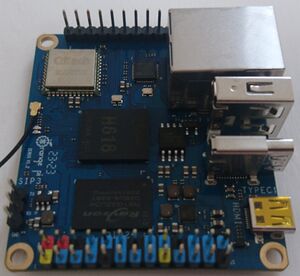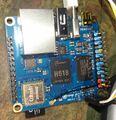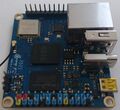Xunlong Orange Pi Zero3
| Xunlong Orange Pi Zero3 | |
|---|---|
| Manufacturer | Xunlong |
| Dimensions | 50mm x 55mm |
| Release Date | Jun 2023 |
| Website | Orange Pi Zero3 |
| Specifications | |
| SoC | H618 @ 1.512 Ghz |
| DRAM | 1/1.5/2/4GiB LPDDR4 @ 792 MHz |
| Power | DC 5V @ 2A via USB-C connector |
| Features | |
| Video | Micro HDMI 2.0a, CVBS on header |
| Audio | Line out on header, HDMI audio |
| Network | WiFi 802.11 a/b/g/n (Cdtech 20U5622), 10/100/1000Mbps Ethernet (Motorcomm YT8531) |
| Storage | µSD, 128Mbit SPI flash (zBit 25VQ128ASIG) |
| USB | 1 X USB2.0 Host, 1 X USB2.0 OTG, 2 X USB2.0 Host on header |
Not to be confused with Orange Pi 3 (H6) or Orange Pi Zero2 (H616). This is the H618 version from 2023. It's a slightly updated successor of the Orange Pi Zero2, with some component, board layout and size changes (see below for more details).
Identification
A serial number sticker can be found on the back of the board:
OPI- Zero3-xGB <SerialNumber>
The PCB has a version number silkscreened nest to the SOC and RAM:
Orange Pi Zero3 v1.2
General Notes
Some differences to the Orange Pi Zero 2:
| Feature | Orange Pi Zero2 | Orange Pi Zero3 |
|---|---|---|
| SoC | H616 | H618 |
| DRAM type | DDR3 | LPDDR4 |
| DRAM sizes | 512MB/1GB | 1/1.5/2/4 GB |
| SPI flash size | 2MB | 16MB |
| PMIC | AXP305 | AXP313a |
| Ethernet PHY | RTL8211F | YT8531C |
For a change, there is some Linux (Android kernel) image on the SPI flash, although it seems to be misconfigured to not show much output on HDMI or serial. It's the usual Allwinner provided BSP kernel, in the very outdated (and hacked) version 4.9.170, compiled by an even older compiler.
The LEDs are software controlled, so won't light up until something is explicitly telling them so. The shipped SPI flash image does so after a few seconds.
Sunxi support
Current status
The Orange Pi Zero3 uses the H618 SoC, which is mostly software compatible with the H616, just with a larger L2 cache and a change in the CPU cluster control IP, affecting TF-A and U-Boot only.
This board is an updated version of the Orange Pi Zero2, but uses a different PMIC, DRAM type and Ethernet PHY, all of which requiring software changes (DT changes and new drivers). Pure Orange Pi Zero2 images will not work. PMIC and Ethernet PHY are already supported by the latest mainline Linux kernel, LPDDR4 and the PMIC are also supported by latest U-Boot.
Images
BSP
TBC
Manual build
You can build things for yourself by following our Manual build howto and by choosing from the configurations available below.
U-Boot
Use the orangepi_zero3_defconfig build target. Available since v2024.01-rc5.
Does not have compatibility for a 1.5GB board.
Linux Kernel
Use the sun50i-h618-orangepi-zero3.dtb device-tree binary from a mainline kernel, available since v6.6.
The PMIC and the Ethernet PHY are supported since v6.5-rc1, so the board just needs the proper DTB to run with this or later kernels.
Expansion ports
The Orange Pi Zero3 has a 26-pin, 0.1" populated connector with several low-speed interfaces.
The primary function follows loosely the old Raspberry Pi pin assignment (TWI3 (aka I2C), UART5, SPI1, GPIOs), but pinmuxing gives access to more interfaces (not all at the same time): UART2 (incl. h/w handshake), TWI2, TWI4, SPDIF, PWM1, PWM2, single bit MMC2.
| 2x13 Header | ||||||||
|---|---|---|---|---|---|---|---|---|
| 3.3V | 1 | 2 | 5V | |||||
| SPI1_CS0 / UART2_TX | PH5 | I2C3-SDA | 3 | 4 | 5V | |||
| SPDIF_OUT | PH4 | I2C3-SCK | 5 | 6 | GND | |||
| PC9 | GPIO-73 | 7 | 8 | UART5-TX | PH2 | SPDIF_CLK / PWM2 / TWI2_SCK | ||
| GND | 9 | 10 | UART5-RX | PH3 | PWM1 / TWI2_SDA | |||
| SCD2_CMD | PC6 | GPIO-70 | 11 | 12 | GPIO-75 | PC11 | ||
| SDC2_CLK | PC5 | GPIO-69 | 13 | 14 | GND | |||
| PC8 | GPIO-72 | 15 | 16 | GPIO-79 | PC15 | SPI0_WP | ||
| 3.3V | 17 | 18 | GPIO-78 | PC14 | ||||
| UART2_RTS / TWI4_SDA | PH7 | SPI1-MOSI | 19 | 20 | GND | |||
| UART2_CTS | PH8 | SPI1-MISO | 21 | 22 | GPIO-71 | PC7 | ||
| UART2_RX / TWI4_SCK | PH6 | SPI1-SCK | 23 | 24 | SPI1-CS | PH9 | ||
| GND | 25 | 26 | GPIO-74 | PC10 | SCD2_D0 | |||
The Orange Pi Zero3 has another 13-pin, 0.1" header with USB and analogue interfaces. The 13-pin interface board originally used for Orange Pi Zero is compatible with Zero3, but the microphone on the board is no longer available.
| 1x13 Header | |
|---|---|
| 1 | 5V |
| 2 | GND |
| 3 | USB2-DM |
| 4 | USB2-DP |
| 5 | USB3-DM |
| 6 | USB3-DP |
| 7 | LINEOUTR |
| 8 | LINEOUTL |
| 9 | TV-OUT |
| 10 | PC1 |
| 11 | PI16 |
| 12 | PI6 |
| 13 | CIR-RX / PH10 |
Tips, Tricks, Caveats
FEL mode
No dedicated FEL button. FEL mode will be entered without an SD card and with no valid eGON signature on the SPI flash. Alternatively the usual FEL trigger SD card image can be used.
The USB-C connector used to power the board carries the USB-OTG signals for the FEL mode, so the board needs to be powered through a host computer or a powered USB hub for using FEL mode.
LEDs
There are two unlabelled LEDs on the board, a red and a green one. According to the schematic they are Power (red) and Status (green), but both are connected to GPIOs (PC12 and PC13), so need active software toggling to light up.
SPI booting
The board contains a 16MB SPI NOR flash chip, and the SoC can boot firmware from there.
Serial port
The UART pins are located near one corner of the board, in a clearly distinct group of three pins. They are marked as TX, RX and GND on the PCB. Just attach some leads according to our UART Howto.




